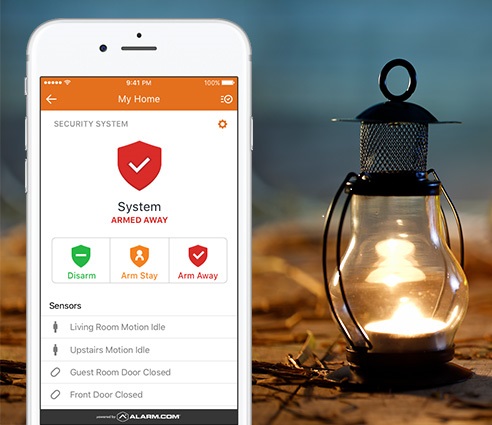When we help customers design their security systems, we take an all-encompassing approach to the task at hand. This requires getting involved with the system design process from the get-go. This also entails recommending basic steps that we take in almost all alarm installs, as well as listening to our customers’ unique needs and designing ways to address these specific concerns. Moreover, our alarm design approach also involves helping customers find the monitoring option that best suits their security needs. Over the past several years, we’ve seen a sharp increase in popularity of self-monitored home security systems. In this post, we explain the pros and cons of this trending form of monitroing, as well as how to best utilize this unique home security service.
First, we’ll answer a couple important questions about burglar alarm monitoring. Specifcally, we’ll explain how we connect alarms to monitoring services in the first place. Following this, well share the differences between traditional central station-based monitoring and self-monitoring your alarm. From there, we’ll look at how to create notifications for every type of security situation that you wish to find out about. Finally, we’ll share some scenarios that you may want to address by upgrading your security monitoring services. Now, let’s dive in by seeing what makes self-monitored home security so unique!
What Does Burglar Alarm Monitoring Entail?
When we install a burglar alarm, we wish to create a couple important layers of security. For starters, an alarm activation creates a blaring siren response to alert anyone on site to the issue. Additionally, this response often serves to scare the perpetrator away as well. Furthermore, we also like to add security by creating a communication component to your security system. Traditionally, this involves connecting our customers’ burglar alarms to our central station. This allows a central station dispatcher to contact you in response to an alarm and, if necessary, even create a police dispatch.

The Alarm.com interactive cellular dialer allows you to control your alarm and receive valuable security alerts wherever you are, at any time.
We can create the ability for our alarm to dial out in a couple different ways. Traditionally, we would connect your alarm to your property’s existing phone lines. However, this can prove problematic, as many people no longer have working phone lines. Moreover, burglars often cut phone lines before attempting a crime in order to disable security monitoring.
For this reason, we recommend installing a dedicated cellular dialer to your alarm, such as our cell dialer powered by Alarm.com. This dialer uses a cellular network to monitor your alarm. Therefore, phone outages will no longer affect your alarm’s monitoring service! We often use our Alarm.com dialer to connect customers’ alarms to our central station. However, the cellular nature of this dialer allows us to provide unique self-monitored home security that can save customers’ some money and perhaps make them more comfortable with their monitoring experience. Let’s hop to the next section to study this option in greater detail!
What Makes Self-Monitored Home Security Unique?
As we mentioned, we generally connect our customers’ alarms to a central station that provides the required response. Of course, this comes with a cost that some customers may not want to pay. In fact, we charge our monitored customers monthly for this service. While we find this fee a reasonable expense, cost-conscious patrons like to keep monthly fees as low as possible. Additionally, some customers do not like the idea of their alarm creating a police dispatch in their absence. This rings especially true for new customers who fear false alarms caused by user error. The advent of false alarm fees charged by some cities and towns make these individuals even more nervous about this possibility.
Our self-monitored customers live without these concerns. Their alarms alert them to any activation or security alerts through the Alarm.com app. This same app lets them control their security system remotely. Furthermore, it allows them to create customizable alerts for events ranging from alarm activations to low sensor batteries to certain doors and windows in their homes opening and closing. The monthly cost of this monitoring option is less than half of the cost of central station monitoring. Moreover, self-monitored customers must call for help themselves in the case of an alarm. This fact greatly lowers the chances of a false alarm causing an unecessary dispatch. With this knowledge under our belts, let’s review the array of alert options provided to our customers.
Creating the Alarm Responses that Work Best for You
As we’ve already touched on, self-monitored security systems do not create a central station or police dispatch. Therefore, you’ll want to know about any alarm activations ASAP so that you can determine the next course of action. For this reason, you’ll certainly want to create an Alarm.com alert anytime your alarm activates. These alert options include text alerts, push notifications, and emails. Additionally, you can have these alerts sent to as many people as you please. Obviously, creating a larger pool of residents and family members to receive these alerts raises your chances of someone responding quickly.
Of course, you’ll want to stay updated to other alarm events as well. You have the ability to receive alerts for less pressing — but still important — security updates. Our most popular non-alarm security notifications have to do with system arming and disarming events. Most of our customers receive a text alert when someone arms or disarms their security system. Furthermore, these alerts also tell you who completed this action, as well as when. Finally, you can also create alerts if an expected arming or disarming event fails to take place.
For example, you may expect your school-aged children to disarm the security system by 3pm every day. If nobody disarms the alarm by that time, you will receive a message. The same goes for arming events as well. Perhaps your house gets locked up in the morning at the same time every day. If this does not happen, you can receive an alert to let you check on the situation. At that point, you can use your phone to quickly address the issue! Next up, let’s take a look at circumstances that may lead you to upgrading your alarm monitoring service.

If you plan on traveling any time soon, we highly recommend upgrading to central station-based alarm monitoring.
When to Upgrade Your Monitoring Service
Self-monitoring your alarm could represent a great way to get comfortable with home security. For some customers, they stick with this option permanently. However, we often recommend upgrading your monitoring to include a central station response. We make this suggestion for a few reasons. For starters, we often install monitored smoke and carbon monoxide (or “CO”) detection in our alarm customers’ homes. Doing so creates a quick fire department response to a fire or CO-related emergency in your home.
Of course, many of these events take place while the residents of a home are sleeping. In these cases, you will miss out on receiving the Alarm.com alerts caused by these emergencies. This means that self-monitored customers’ homes and, more importantly, even their lives, are in great danger in these instances. However, adding central station monitoring will ensure that a fire truck gets to your home as quickly as possible in these situations.
Furthermore, we also recommend adding central station monitoring if you plan on doing any traveling. Self-monitored customers who travel often miss their alarm alerts. This leads to a failure to react to an emergency at home until well after the fact. Of course, this risk increases greatly when families travel to different area codes. While self-monitoring can work at times, some situations call for central station support to enjoy true security and peace of mind.
Putting it All Together
We hope that this post helps you understand how self-monitored home security and traditional central station-based monitoring differs. Additionally, we encourage you to contact us with any questions that this post may raise for you. We will happily answer any and all of your security-related inquiries. Furthermore, we also invite you to take advantage of our free site survey program. We provide complimentary security audits and quotes for security equipment and services for free. Perhaps you have some security equipment in place but wish to take advantage of some of the monitoring options you’ve just read about. Or, maybe you have very little in the way of security now, and want to get started. Either way, we are happy to help! Together, we can create a complete security plan to keep you, your home, and your family as safe and secure as possible!
